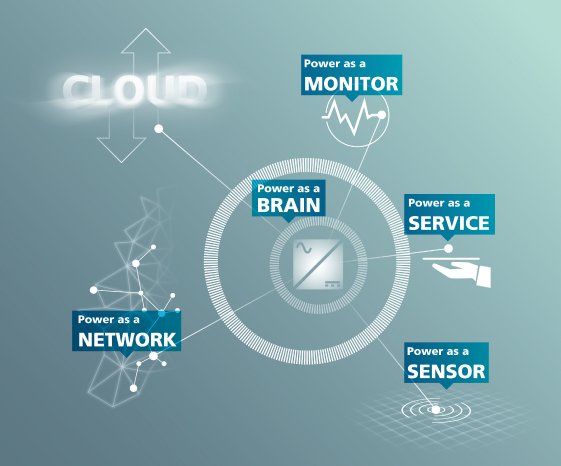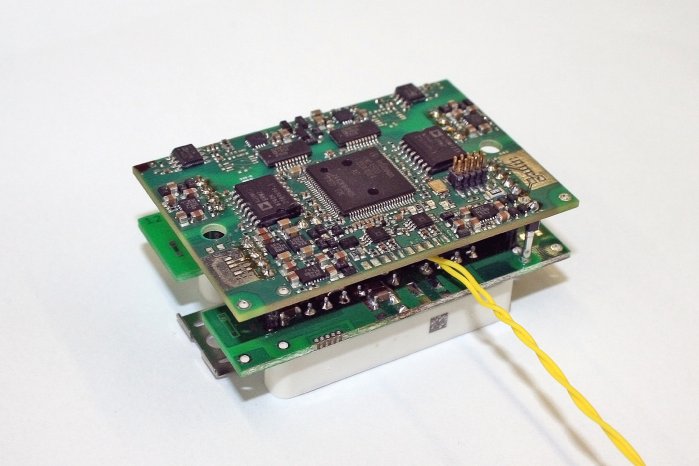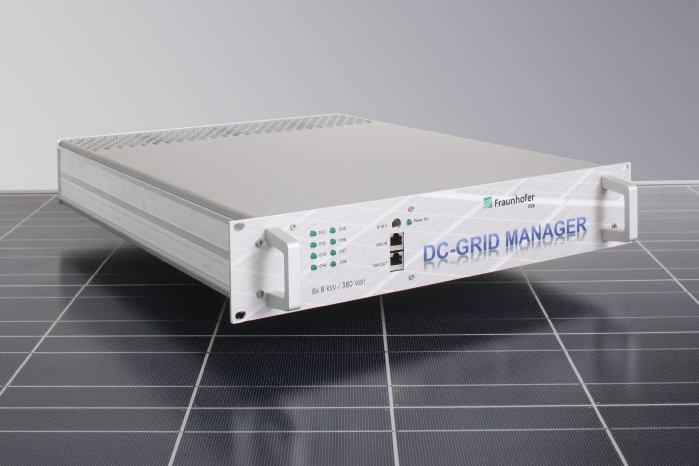The Fraunhofer Institute for Integrated Systems and Device Technology IISB in Erlangen offers innovative power electronic solutions that are used in conversion, supply, and storage of electrical energy. Based on years of experience and application in these various fields, Fraunhofer IISB drives power electronics to the next level by merging proven power electronic systems and devices with smart functionalities, enabling the new era of „Cognitive Power Electronics 4.0“. The latest developments by Fraunhofer IISB are presented at PCIM Europe, the international leading exhibition for power electronics, intelligent motion, renewable energy and energy management, taking place from 16 to 18 May 2017 in Nuremberg, Germany, at booth 6-339.
Cognitive Power Electronics 4.0 by Fraunhofer IISB
In power converters, for instance, additional controllers can be embedded to enable advanced connectivity and intelligence. Based on available data, such as currents, voltages, phasing, temperatures, or impedance, a converter can control the attached electrical system and react to changes in the environment. This approach also makes the attached system (e.g., a battery) “smart”.
Building on highly efficient and compact power electronics far beyond the state of the art, and combining it with novel approaches featuring connected services, Cognitive Power Electronics 4.0 enables new functionalities in the Fraunhofer IISB concept of five major “Power as…” areas, where the institute covers novel applications and offers tailored solutions:
Power as a Service
Power electronics by Fraunhofer IISB offers a modular design combined with plug-and-play functionality, with focus on the actual application. Hardware and software of the novel power converters are reconfigurable. The converter detects changes in its environment (e.g., mode of utilization, fluctuations in the power grid) and adapts to the needs of the respective application. Beyond this adaptability, the converter can be fail-operational and fault-tolerant: if a hardware component of the electrical system fails, the converter acts accordingly to keep the application running.
Applications and solutions:
• DC-Grid Manager and Modular Power Distribution System (MPDS) by Fraunhofer IISB facilitate the flexible setup of DC grids and their simple reconfiguration without compromising grid stability.
• Converters with embedded Droop Control enable safe plug-and-play scenarios and facilitate stable grids on the fly when energy providers or users are connected or disconnected.
• An MPDS equipped with intelligent controllers enables smart batteries, with online information about battery/cell state or active battery analysis.
• An MPDS equipped with intelligent controllers balances utilization by energy users and control parameters for solar panels according to current demand and energy prices.
Power as a Sensor
The novel power electronics by Fraunhofer IISB acts as sensors and can be used as sensor platforms. Data is the basis for smart decisions and advanced control strategies – and such data (e.g., currents, voltages, phasing, and temperatures) is already an inherent part of, e.g., a power converter. This internal sensing is augmented by external sensors (e.g., vibration, revolution speed) that are powered by the converter and send their data to the converter via standard interfaces. All this sensor information can either be utilized internally by the power converter itself, or sent to external entities for external analysis or direct control of actuators.
Applications and solutions:
• A power converter as sensor platform acts as a gateway to plug in additional sensors, aggregate incoming data, and send information to external systems via standardized interfaces (e.g., CAN, home-automation interface).
• Utilization of internal sensing from the converter eliminates the need for additional power meters.
• Electronics for voltage monitoring of batteries is implemented with double or triple redundancy with respect to sensors and cabling, fostering a fail-safe or fail-operational behavior of the overall system in safety-critical applications such as automotive or aviation.
• In cases of contactless energy transmission (e.g., inductive coupling), the coupling is used to power a sensor and collect data from places where traditional wiring is too complicated or not possible at all, e.g., measuring temperature and vibration in an automatic gearbox, or adding sensors and actuators to the vanes of wind turbines.
Power as a Monitor
Building on the sensor platform, the novel power electronics monitors data from internal and external sensors and turns this data into information. Since the actual behavior of an application and its environment is reflected in this data, a tailored data analysis right on the power converter can be used for fault detection of the electronic system (e.g., detection of electric arcs) or for real-time optimization of an application (e.g., with regard to energy consumption or changes in a power grid). Beyond that, on-board data analysis enables active metering, extended self-test or health monitoring for connected devices (e.g., batteries), and can turn raw data to aggregated data for external usage.
Applications and solutions:
• A power converter with monitoring capabilities detects impedance changes of a battery, or short circuits and enters into a safe state.
• A power converter is equipped with intelligence for self-test and self-monitoring to characterize and check its internal behavior (e.g., during start-up), or to compare internal and external voltages for fault detection.
• Incoming information about a temperature overshoot in a connected system is used for automated power derating and self-protection.
• Power electronics coupled to a machine (e.g., a pump in a cleanroom environment) monitors the trend of electric parameters that are correlated to the machine state and adapts power in case of fluctuation or raises an alarm in case of failure.
Power as a Network
Power converters by Fraunhofer IISB can be combined for additional functionality, and they connect to their environment. The combination of converters fosters a higher fault tolerance and is the basis for distributed intelligence, which enables advanced control strategies with shifting responsibility instead of fixed master-slave control. In addition, the converters connect to existing networks and cloud environments to enable additional functionality, such as remote control, remote maintenance, or distributed power control.
Applications and solutions:
• Each converter in a network of power converters can be forced to enter a faulty state if any of the connected converters detects a failure mode.
• Connected converters are the basis for the management of power grids comprising regenerative and decentralized power sources (e.g., solar cells and wind turbines).
• Connected converters provide redundancy, where one converter replaces the functionality of another one in case of failure.
Power as a Brain
Power electronics by Fraunhofer IISB enables smart functionality exploiting its on-board intelligence. The computing power of modern power converters is utilized to implement advanced data analysis and tailored machine learning algorithms to realize self-learning and self-adapting converters, or to implement predictive maintenance for the overall electronic system and application. Finally, the converter realizes the “digital twin” of the connected system and complements the connected system to form a CPS (cyber-physical system), the basis for Industry 4.0.
Applications and solutions:
• A self-learning power converter adapts to grid disturbances or activation/deactivation of connected systems without the need for manual adaptation. It reacts accordingly to incidents, such as load shedding, or even aging isolations.
• Several instances of the battery management system foxBMS by Fraunhofer IISB are connected to form a distributed intelligence: all instances are aware of the maximum currents, and voltages and temperatures in the battery systems and agree on the overall coordination and the point of connection to higher-level control systems.
• A model of the connected system (e.g., of a battery or a manufacturing machine) is embedded in the power converter, providing it an “understanding” of the connected system. The converter is now able to carry out advanced data analysis in the context of the overall system – e.g., detecting faulty states on a machine, providing a root-cause analysis for detected faults, or predicting maintenance events such as tool or module exchange.
Focus: Cognitive Power Electronics 4.0 for DC Microgrids
State-of-the-art power electronics converts the battery or PV voltage and currents to the corresponding grid values and is for many applications the key element in the power path. It is available with all kind of communication interfaces, can be controlled via apps and can be connected to cloud and database systems. Cognitive Power Electronics 4.0 even goes beyond this advanced power electronic solutions and includes different metrologies, like automatic configuration (plug & play), self-learning, analyzing local measured data, autonomous adaption of control/stability parameters and validation of incoming control data.
DC-Grid Manager 2.0
With the presented DC-Grid Manager, a complete plug-and-play solution with a self-parametrizing controller and automatic configuration of the local (grid-tied or OFF-grid) DC microgrids in buildings is available. The DC-Grid Manager combines the entire power electronics to generate, store and use renewable energy from independent PV strings with a very high efficiency in a very flexible way and can be installed easily.
The DC-Grid Manager 2.0 has eight flexibly configurable channels connected to the common DC bus. Each channel can interface to a different device (e.g., PV string, battery system, or fuel cell). The function of each channel can be configured and also changed on the fly with software. For example, when connected to a PV string, the channel can operate as maximum power point tracker (MPPT) and can autonomously find the best algorithm for the connected string on basis of the profile data.
The DC-Grid Manager also includes an impedance measurement method to arise local information about the DC microgrid and the connected devices. This data can be monitored to a cloud or/and analyzed locally to autonomously react, e.g., on plug and unplug events, and to stabilize the grid even in application with hard real-time environments.
DC-Power Supply
The DC-Power Supply by Fraunhofer IISB is an insulating and bidirectional 500W DC/DC-converter. The DC/DC-converter supplies itself solely from the microgrid, no further auxiliary supply is needed. If the DC-Power Supply is connected to a network or cloud it can also monitor and help to analyze the power quality and consumption.
In SELV Grids (Safety Extra Low Voltage), the DC-Power Supply is the central gateway for powering and could also be used as a communication hub for all connected devices, sensors, and actors. The DC Power Supply does not only send the data to a cloud or database; it can learn from the profiles of the devices to manage the system in an optimal way and even in an OFF-grid mode. Also maintenance prediction, advanced fault detection and battery status can be used for autonomous operation strategies.
Modular Power Distribution System (MPDS)
Modular Power Distribution System provides a scalable and flexible solution for connecting various renewable energy sources and storage systems to ±380 VDC microgrids ranging from a few kilowatts up to hundred kilowatts. The system consists of several power modules and an Energy Flow Controller and is housed in a 19’’ system with only 3 HU. There are different and freely configurable DC/DC converter modules available for the MPDS.
For example, the power modules are DC/DC converters which are connected between the microgrid and energy sources and storage. There are also modules available which compensate power imbalances between the two phases of the ±380 VDC microgrid. Each power module is hot-pluggable. For applications requiring higher power, the power modules can be connected in parallel.
Voltage regulation in the Modular Power Distribution System is performed autonomously by a Voltage Droop Control algorithm. No software configuration is necessary for the basic functionality. On the other hand, the MPDS is very flexibly configurable due to digital controllers and if connected to a network it enables advanced functionality, like virtual coupled DC/DC converters in battery systems.
The Energy Flow Controller communicates with all power modules and system components as a superordinate controller of the microgrid.
Focus: Battery Management
foxBMS – Open and Flexible Battery Management System
This system by Fraunhofer IISB is the first really universal development environment and platform providing a fully open-source battery management system able to manage modern and complex energy storage systems by providing distributed intelligence. Each BMS slave can monitor the temperatures and voltages of up to 18 cells, in battery systems up to 1000V. The number of BMS slaves is virtually unlimited: they are connected to BMS master units by using a specific architecture providing distributed intelligence. foxBMS, inter alia, facilitates health monitoring for batteries, by exactly following each charge/discharge cycle: the system reports the actual capacity (SOH: state of health) and predicts the rest of useful life of the battery (SOL: state of life) when the current use case is maintained.
More information can be found on www.foxbms.org.
Focus: Software-defined Power Electronics (SDPE)
Power Control via Novel 2-wire Interface for Future Industry 4.0 Applications
The IPU (intelligent power unit) by Fraunhofer IISB is another example which combines all five “Power as…” aspects. Cognitive Power Electronics 4.0 means to go far beyond state-of-the-art solutions. The IPU based on a full-bridge power module and a novel 2-wire interface technology is an impressive example. Whereas state-of-the-art intelligent power modules (IPMs) only combine a power module with gate drive functionality and some sensors, an intelligent power unit is a software-defined power processing unit, easy and plug-and-play controlled, programmed and supplied via only two wires. Hence, the same IPU can be used, e.g., for buck-derived, boost-derived as well as for interleaved versions or resonant converters in totally different applications like isolated or non-isolated AC/DC, DC/DC and DC/AC converters.
Images for editorial use can be found at www.iisb.fraunhofer.de/press.
Visit Fraunhofer IISB at PCIM Europe 2017, May 16-18, in Nuremberg at booth 6-339!







